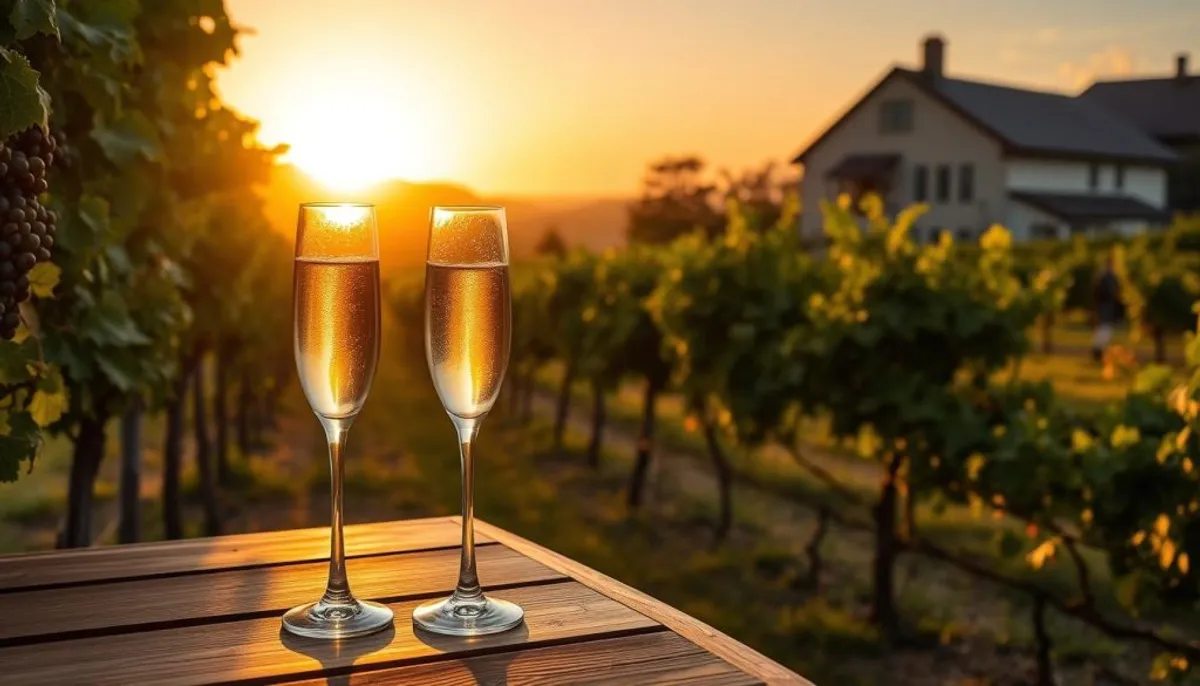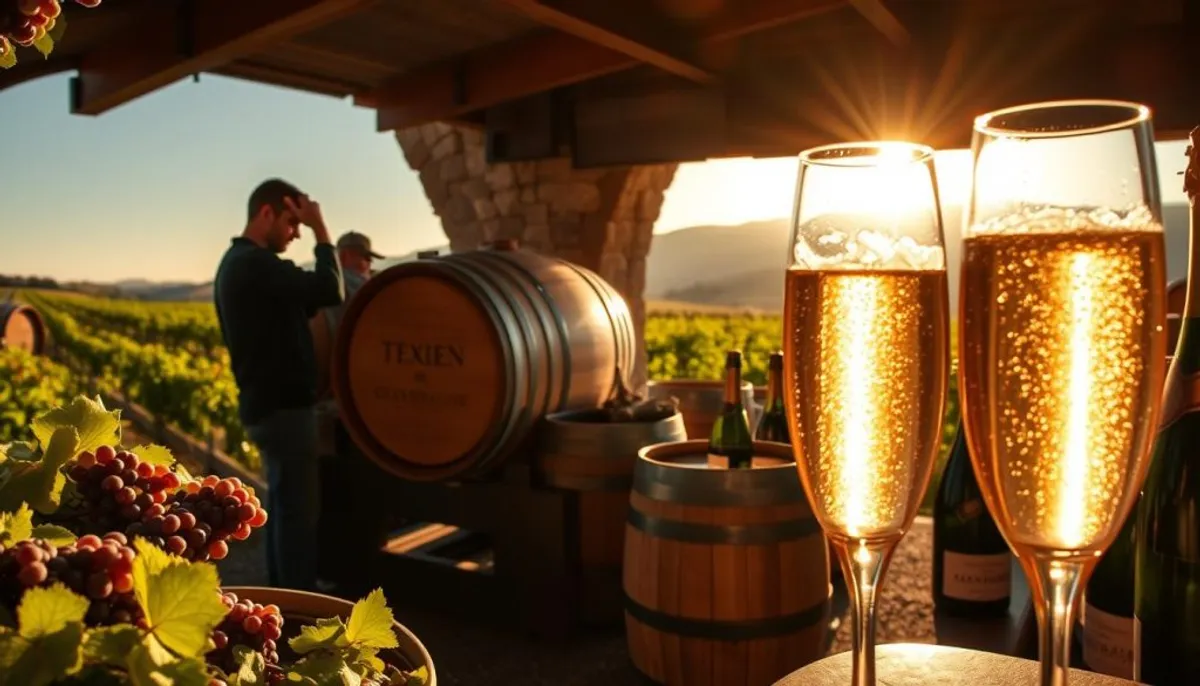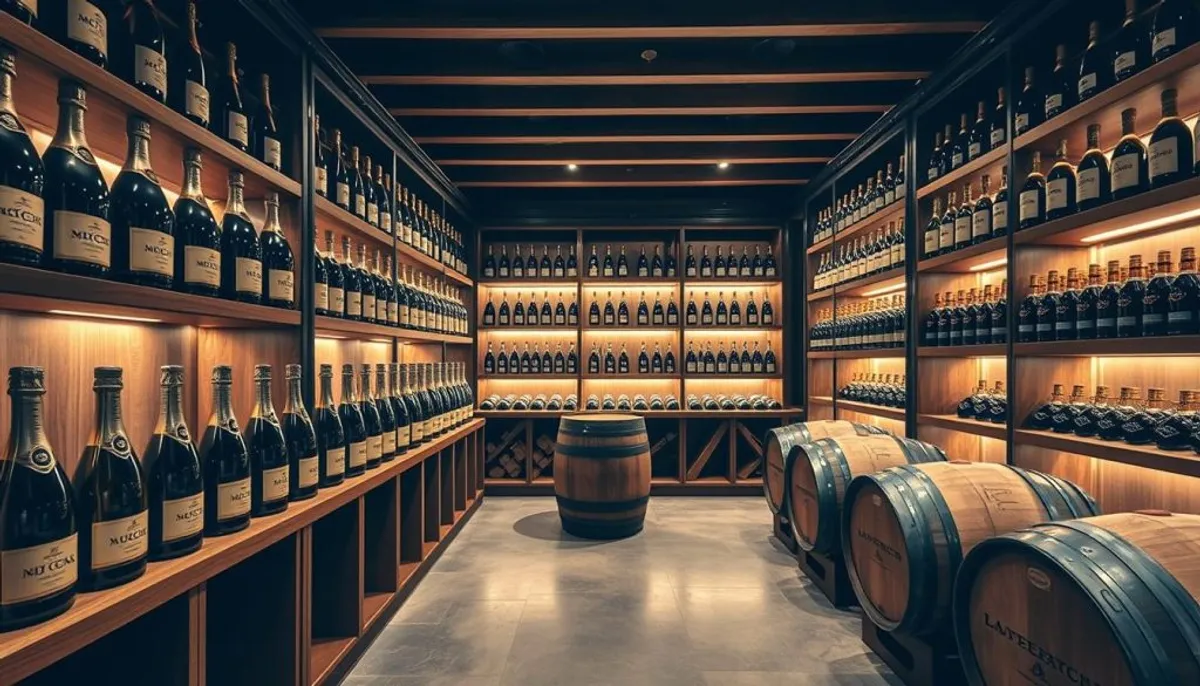Step into the world of luxury sparkling wine with MCC Champagne, the crown jewel of French bubbly. This exquisite beverage hails from the renowned Champagne region. Here, centuries of tradition meet modern winemaking expertise. The result? A sparkling masterpiece that captivates wine lovers worldwide.
MCC Champagne stands out for its use of the traditional method. This meticulous process gives birth to those tiny, perfect bubbles we all adore. This time-honored technique, perfected in the Champagne region, is the secret behind the wine’s unparalleled quality and prestige.

What sets MCC Champagne apart is not just its origin but the strict regulations that govern its production. Only sparkling wines crafted within the Champagne region can bear this esteemed name, a privilege protected by international treaties. This exclusivity ensures that every sip of MCC Champagne is a taste of French heritage and excellence.
Key Takeaways
- MCC Champagne is exclusively produced in the Champagne region of France
- The traditional method creates its signature fine bubbles and complex flavors
- International treaties protect the Champagne name and production standards
- MCC Champagne offers a luxurious drinking experience
- The Champagne region’s unique terroir contributes to the wine’s distinct character
Understanding the Legacy of French Sparkling Wine
The history of French wine is marked by innovation, with the Champagne region at its forefront. The méthode champenoise, a centuries-old technique, transformed sparkling wine production. It is responsible for the distinctive bubbles and intricate flavors that characterize premium sparkling wines today. Understanding the veuve clicquot history adds depth to this narrative, showcasing the contributions of notable producers in the region.
The Historical Origins of Traditional Method
The roots of traditional sparkling wine production lie in the Champagne region of France. Monks in the 17th century refined this method, which involves a second fermentation in the bottle. Known as méthode champenoise, it has since been adopted globally, influencing winemakers everywhere.
The Protected Designation of Origin
The Champagne appellation, a safeguard for the region’s wines, is governed by strict regulations. Only wines from this specific area can bear the name Champagne. This ensures the preservation of traditional methods and upholds the region’s esteemed status in French wine history.
The Champagne Region’s Unique Terroir
The terroir of the Champagne region is pivotal in crafting its celebrated sparkling wines. The chalky soil and cool climate are key factors, contributing to the grapes’ acidity and flavor. These elements are crucial for producing sparkling wines of the highest quality.
| Factor | Impact on Champagne |
|---|---|
| Soil Composition | Chalk-rich, enhances minerality |
| Climate | Cool, promotes acidity in grapes |
| Grape Varieties | Chardonnay, Pinot Noir, Pinot Meunier |
| Production Method | Méthode Champenoise |
MCC Champagne: A Masterpiece of Winemaking
MCC Champagne is the epitome of luxury in the world of sparkling wines. It represents the highest echelons of French winemaking, combining centuries-old traditions with meticulous craftsmanship. The MCC Nectar Blanc de Blanc 2022, crafted from the finest Chardonnay grapes, exemplifies this mastery.
This sparkling wine dazzles with its pale gold color and crystal clarity. Its effervescence, created by tiny, persistent bubbles, is both captivating and refreshing. The aroma is a harmonious blend of fresh green apple, pear, and floral notes, including acacia and honeysuckle.
The palate of MCC Nectar Blanc de Blanc 2022 is a complex tapestry of flavors. It begins with green apple and pear, complemented by citrus undertones. White peach and apricot add depth, while a subtle minerality and toasted brioche notes enhance its complexity. This exquisite wine can also be enjoyed as a brunch dish, making it a versatile choice for various occasions. The finish is long and balanced, showcasing a perfect harmony between acidity and fruitiness.
| Characteristic | Description |
|---|---|
| Color | Radiant pale gold |
| Aroma | Green apple, pear, white peach, acacia, honeysuckle |
| Palate | Green apple, pear, citrus, white peach, apricot, minerality, toasted brioche |
| Finish | Long, balanced acidity and fruitiness |
| Pairing | Oysters, shellfish, seafood, risottos, light poultry, fine cheeses, fruit tarts |
This premium sparkling wine is a versatile companion for a variety of dishes, from oysters to creamy risottos. Its adaptability makes it perfect for any celebratory event, from weddings to sophisticated gatherings. The MCC Nectar Blanc de Blanc 2022 showcases the pinnacle of French winemaking’s artistry and elegance.
The Traditional Méthode Champenoise Process
The méthode champenoise stands as the quintessence of Champagne production. This meticulous process is responsible for the wine’s distinctive bubbles and intricate flavors. It transforms still wine into a sparkling masterpiece, cherished by connoisseurs worldwide.
First Fermentation Steps
The journey commences with the harvesting of grapes at low sugar levels. Winemakers then craft a base wine through initial fermentation. This foundational step establishes the sparkling wine’s character.
Second Fermentation in Bottle
Bottle fermentation is the pivotal moment. Winemakers introduce yeast and sugar to the base wine, sealing it in bottles. This second fermentation ensues, trapping CO2 and generating the wine’s signature bubbles.
Aging on Lees
Lees aging is pivotal for enhancing complexity in luxury outdoor living. The wine rests on dead yeast cells for 15 to 36 months. This period imparts creamy, yeasty notes, defining premium sparkling wines.
Riddling and Disgorging
Riddling involves the gradual turning and tilting of bottles to collect sediment in the neck. Disgorging then removes this sediment, leaving the wine clear. A final touch of sweetness, known as dosage, determines the wine’s style, ranging from Brut Nature to Doux.

| Process Step | Duration | Key Outcome |
|---|---|---|
| First Fermentation | 1-2 weeks | Base wine creation |
| Bottle Fermentation | 4-8 weeks | Bubble formation |
| Lees Aging | 15-36 months | Flavor complexity |
| Riddling | 1-2 months | Sediment collection |
| Disgorging | 1 day | Sediment removal |
Distinguished Characteristics of Premium Sparkling Wines
Premium sparkling wines, such as MCC Champagne, are renowned for their exceptional qualities. They enthrall aficionados with their fine bubbles, intricate flavors, and sharp acidity. The meticulous production process is instrumental in crafting these unique attributes.
The traditional method of in-bottle fermentation is responsible for their effervescence. Tiny, persistent bubbles in the glass create a captivating visual spectacle. This distinctive feature distinguishes premium sparkling wines from others.
These wines are celebrated for their complex flavors. Citrus, apple, and brioche notes blend with subtle minerality. The extended aging on lees adds a creamy texture and depth, enhancing the tasting experience.
The crisp acidity in these wines balances their rich flavors, creating a harmonious palate. This refreshing quality makes them versatile for pairing with various dishes or enjoying solo, including delightful kosher champagne food pairings.
| Characteristic | Description |
|---|---|
| Bubbles | Fine, persistent |
| Flavors | Complex, citrus, apple, brioche |
| Acidity | Crisp, refreshing |
| Texture | Creamy, elegant |
| Finish | Long, balanced |
The balanced structure and long, elegant finish of these wines leave a lasting impression. Premium sparkling wines offer a unique sensory journey, appealing to both wine connoisseurs and casual drinkers.
Comparing French Champagne and Global Sparkling Wines
The realm of sparkling wines is vast, showcasing a myriad of styles and flavors. A comparative analysis of sparkling wines uncovers the distinct attributes of various global wine regions. From the esteemed French Champagne to the innovative creations of the New World, each style contributes uniquely to the sparkling wine landscape.
French Champagne vs. MCC
French Champagne is the paragon of sparkling wines, crafted exclusively in the Champagne region under rigorous regulations. The primary grape varieties include Pinot Noir, Meunier, and Chardonnay. In contrast, South African Méthode Cap Classique (MCC) employs the traditional method but allows for greater flexibility in grape selection. Notably, while Champagne commences at approximately R500 per bottle, MCC presents a more affordable option at roughly R200.
Prosecco and Cava Distinctions
Italy’s Prosecco and Spain’s Cava embody distinct wine styles. Prosecco, predominantly crafted from Glera grapes, undergoes secondary fermentation in large tanks, a process known as Charmat. This method imparts fresh, fruity flavors. In contrast, Cava adheres to the traditional method akin to Champagne but utilizes native Spanish grapes. These differences yield unique flavor profiles that mirror their respective origins.
New World Sparkling Innovations
New World wine regions are revolutionizing the sparkling wine landscape through artisanal winemaking. Tasmania and England are producing exceptional bottles that rival traditional Champagne in quality and complexity. These regions benefit from cool climates, ideal for cultivating grapes with high acidity, a crucial element in crafting crisp, balanced sparkling wines. Their pioneering approaches are broadening the horizons of sparkling wine production, captivating wine aficionados globally.
| Wine Style | Region | Main Grapes | Method |
|---|---|---|---|
| Champagne | Champagne, France | Pinot Noir, Meunier, Chardonnay | Traditional |
| MCC | South Africa | Various | Traditional |
| Prosecco | Veneto, Italy | Glera | Charmat |
| Cava | Catalonia, Spain | Macabeo, Parellada, Xarel·lo | Traditional |
Essential Grape Varieties and Blending
The art of crafting MCC Champagne is rooted in the meticulous selection and blending of key grape varieties. Chardonnay, Pinot Noir, and Pinot Meunier are the core components of these exquisite sparkling wines. Each grape contributes distinct qualities, blending harmoniously to create a symphony of flavors and aromas.
Chardonnay brings elegance and finesse to the blend, while Pinot Noir adds body and structure. Pinot Meunier, with its fruitiness and roundness, completes the trio of classic Champagne grapes. The exact blend varies among producers, resulting in diverse house styles and flavor profiles.
In the Western Cape of South Africa, winemakers incorporate these traditional varieties alongside local favorites for their Méthode Cap Classique (MCC) sparkling wines. Chenin Blanc, a versatile grape, often complements MCC blends, adding crisp acidity and floral notes.
| Grape Variety | Contribution to Cuvée | Typical Usage |
|---|---|---|
| Chardonnay | Elegance, finesse | Dominant in Blanc de Blancs |
| Pinot Noir | Body, structure | Key for Blanc de Noirs |
| Pinot Meunier | Fruitiness, roundness | Adds complexity to blends |
| Chenin Blanc | Acidity, green apple notes | Popular in South African MCC |
The mastery of blending these varieties is essential in crafting the signature taste and character of each Champagne house. This artful process ensures that every bottle of MCC Champagne offers a unique and memorable tasting experience. Understanding the veuve clicquot history adds depth to the appreciation of these exquisite wines.
Tasting Notes and Flavor Profiles
Wine tasting transcends mere consumption, evolving into an art form. MCC Champagne stands as a masterpiece for sensory exploration. Its flavor descriptors weave a complex narrative of aromas and tastes.
Aroma Characteristics
MCC Champagne introduces itself with a bouquet of citrus, green apple, and white flowers. A subtle brioche note adds depth, a testament to the wine’s lees aging process.
Palate Structure
The palate of MCC Champagne is a symphony of balance. Fine bubbles caress the tongue, complemented by crisp acidity and a creamy texture. Fruit flavors intertwine with yeasty undertones, crafting a rich taste experience.
Finish and Length
The finish of MCC Champagne is both long and refined. Flavors persist, evolving in the glass, beckoning further discovery.
| Aspect | Characteristics |
|---|---|
| Aroma | Citrus, green apple, white flowers, brioche |
| Palate | Fine bubbles, crisp acidity, creamy texture |
| Finish | Long, elegant, evolving flavors |
| Aging | Minimum 9 months |
| Grapes | Chardonnay, Pinot Noir, Chenin Blanc |
Food Pairing and Serving Suggestions
MCC Champagne stands out as a versatile companion to diverse cuisines. Its effervescence and acidity pair perfectly with seafood delicacies. Oysters and caviar, with their briny flavors, harmonize beautifully with MCC. The bubbles enhance the palate, cleansing it between bites. Additionally, it serves as an excellent brunch dish, elevating the dining experience with its refreshing qualities.
For a unique twist, MCC pairs well with pizza or biltong. The contrast between the sparkling wine’s crisp notes and these savory foods is delightful. Breakfast and brunch dishes, such as eggs Benedict, also complement MCC, ideal for daytime celebrations.
Serving temperature is key to enjoying MCC Champagne. Chill your bottle to 45-50°F (7-10°C) before serving. This temperature range preserves the wine’s delicate flavors and refreshing effervescence.
Choose tall, narrow flutes for glassware. These glasses maintain the bubbles longer and concentrate the aromas, enhancing your tasting experience. For a luxurious experience, pair a Blanc de Blancs MCC with scallops or a rosé MCC with duck breast.
| MCC Type | Food Pairing | Serving Temperature |
|---|---|---|
| Blanc de Blancs | Oysters, Scallops | 45°F (7°C) |
| Rosé | Duck Breast, Strawberries | 48°F (9°C) |
| Brut | Caviar, Mushroom Risotto | 50°F (10°C) |
While these pairings enhance the MCC experience, don’t hesitate to enjoy your sparkling wine on its own. MCC Champagne’s versatility makes it suitable for any occasion, whether special or everyday.
Investment and Collection Value
Wine investment has surged, with vintage Champagne at the forefront. The market for fine sparkling wines is expanding, drawing in both collectors and investors. Let’s examine why MCC Champagne is a valuable asset for any wine collection.
Aging Potential
Premium MCC Champagnes exhibit remarkable aging potential. Non-vintage blends are best savored within a few years, whereas vintage cuvées can mature for decades. Some producers extend aging to up to 60 months on lees, which boosts both flavor and investment appeal. For those looking to make informed decisions, a sampen price comparison can be incredibly helpful in assessing value and quality.
Storage Requirements
Ensuring proper cellar conditions is vital for maintaining wine quality and investment value. MCC Champagne should be stored in a cool, dark environment with consistent temperature and humidity. Optimal storage temperatures are between 10-13°C (50-55°F), with 70-80% humidity.

Market Trends
The MCC Champagne market is experiencing significant growth. Rare vintages and prestige cuvées command high prices at auctions. Since the 1990s, South African MCC wines have gained recognition, offering promising investment opportunities. Producers like Graham Beck and Simonsig have played a key role in increasing the popularity of these sparkling wines, particularly through their commitment to artisanal winemaking.
| Factor | Impact on Investment |
|---|---|
| Aging Duration | Longer aging (up to 60 months) increases value |
| Vintage Year | Exceptional vintages fetch higher prices |
| Producer Reputation | Established brands like Graham Beck boost value |
| Storage Conditions | Proper cellar conditions preserve investment |
Investing in MCC Champagne demands an understanding of market trends, producer reputations, and optimal storage practices. With the right care and selection, these sparkling wines can generate substantial returns, pleasing both collectors and enthusiasts.
Conclusion
MCC Champagne epitomizes luxury sparkling wine, encapsulating centuries of French wine mastery. It has inspired winemakers globally, notably South Africa’s Methode Cap Classique (MCC) industry. This sector is growing at a remarkable 15% annually, highlighting the worldwide allure of French-inspired sparkling wines.
The MCC category’s dedication to quality is clear in its stringent production standards. With a minimum aging of 9 months on lees, and a push to reach 12 months, MCC producers aim to create complex, refined sparkling wines. The use of traditional Champagne grape varieties—Chardonnay, Pinot Noir, and Pinot Meunier—demonstrates the influence of French winemaking traditions.
MCC presents a wide array of styles, from crisp Blanc de Blancs to elegant rosés, showcasing South Africa’s unique terroir. The annual International Cap Classique Day on September 1st honors this French-inspired yet distinctly South African luxury sparkling wine. As MCC gains international acclaim, it serves as a testament to the lasting legacy and universal appeal of French wine excellence in celebratory beverages.
RelatedRelated articles



